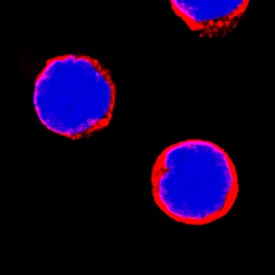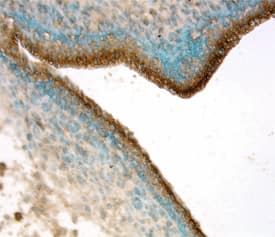Human Ephrin-B3 Antibody Summary
Leu28-Ser224
Accession # Q15768
Customers also Viewed
Applications
Please Note: Optimal dilutions should be determined by each laboratory for each application. General Protocols are available in the Technical Information section on our website.
Scientific Data
 View Larger
View Larger
Detection of Mouse and Rat Ephrin‑B3 by Western Blot. Western blot shows lysates of mouse brain tissue and rat brain tissue. PVDF membrane was probed with 1 µg/mL of Goat Anti-Human Ephrin-B3 Antigen Affinity-purified Polyclonal Antibody (Catalog # AF395) followed by HRP-conjugated Anti-Goat IgG Secondary Antibody (Catalog # HAF019). A specific band was detected for Ephrin-B3 at approximately 36 kDa (as indicated). This experiment was conducted under reducing conditions and using Immunoblot Buffer Group 1.
Preparation and Storage
- 12 months from date of receipt, -20 to -70 °C as supplied.
- 1 month, 2 to 8 °C under sterile conditions after reconstitution.
- 6 months, -20 to -70 °C under sterile conditions after reconstitution.
Background: Ephrin-B3
Ephrin-B3, also known as NLERK-2, Elk-L3, EFL-6, ELF-3 and LERK-8 (1), is a member of the Ephrin ligand family which binds members of the Eph receptor family. All ligands share a conserved extracellular sequence, which most likely corresponds to the receptor binding domain. This conserved sequence consists of approximately 125 amino acids (aa) and includes four invariant cysteines. The B-class ligands are transmembrane proteins which can be tyrosine phosphorylated upon receptor ligation. The cytoplasmic domains are approximately 80 aa long and are highly conserved, especially the last 33 aa. Several signaling molecules have been shown to interact with the cytoplasmic region, although specific signaling roles have yet to be elucidated. Ephrin-B3 has been shown to bind EphA4, EphB1, EphB2, and EphB3 (2, 3). The extracellular domains of murine and human Ephrin-B3 share 98% aa identity. Only membrane-bound or Fc-clustered ligands are capable of activating the receptor in vitro. While soluble monomeric ligands bind the receptor, they do not induce receptor autophosphorylation and activation (2). In vivo, the ligands and receptors display reciprocal expression (3). It has been found that nearly all the receptors and ligands are expressed in developing and adult neural tissue (3). The Ephrin/Eph families also appear to play a role in angiogenesis (3).
- Eph Nomenclature Committee [letter]. Cell (1997) 90:403.
- Flanagan, J.G. and P. Vanderhaeghen (1998) Annu. Rev. Neurosci. 21:309.
- Pasquale, E.B. (1997) Curr. Opin. Cell Biol. 9:608.
Product Datasheets
Citations for Human Ephrin-B3 Antibody
R&D Systems personnel manually curate a database that contains references using R&D Systems products. The data collected includes not only links to publications in PubMed, but also provides information about sample types, species, and experimental conditions.
5
Citations: Showing 1 - 5
Filter your results:
Filter by:
-
The Value of EphB2 Receptor and Cognate Ephrin Ligands in Prognostic and Predictive Assessments of Human Breast Cancer
Authors: Abdul Shukkur Ebrahim, Zeyad Hailat, Sudeshna Bandyopadhyay, Daniel Neill, Mustapha Kandouz
International Journal of Molecular Sciences
-
Registry of Compartmental Ephrin-B3 Guidance Patterns With Respect to Emerging Multimodal Midbrain Maps
Authors: Jeremiah P. C. Stinson, Cooper A. Brett, Julianne B. Carroll, Mark L. Gabriele
Frontiers in Neuroanatomy
-
Blood vessels guide Schwann cell migration in the adult demyelinated CNS through Eph/ephrin signaling
Authors: Beatriz Garcia-Diaz, Corinne Bachelin, Fanny Coulpier, Gaspard Gerschenfeld, Cyrille Deboux, Violetta Zujovic et al.
Acta Neuropathologica
-
Intracellular and trans-synaptic regulation of glutamatergic synaptogenesis by EphB receptors.
Authors: Kayser MS, McClelland AC, Hughes EG, Dalva MB
J. Neurosci., 2006-11-22;26(47):12152-64.
Species: Rat
Sample Types: Whole Cells
Applications: ICC -
The EphB4 receptor-tyrosine kinase promotes the migration of melanoma cells through Rho-mediated actin cytoskeleton reorganization.
Authors: Yang NY, Pasquale EB, Owen LB, Ethell IM
J. Biol. Chem., 2006-08-31;281(43):32574-86.
Species: Mouse
Sample Types: Cell Lysates, Whole Cells
Applications: Flow Cytometry, Western Blot
FAQs
No product specific FAQs exist for this product, however you may
View all Antibody FAQsIsotype Controls
Reconstitution Buffers
Secondary Antibodies
Reviews for Human Ephrin-B3 Antibody
There are currently no reviews for this product. Be the first to review Human Ephrin-B3 Antibody and earn rewards!
Have you used Human Ephrin-B3 Antibody?
Submit a review and receive an Amazon gift card.
$25/€18/£15/$25CAN/¥75 Yuan/¥2500 Yen for a review with an image
$10/€7/£6/$10 CAD/¥70 Yuan/¥1110 Yen for a review without an image
















